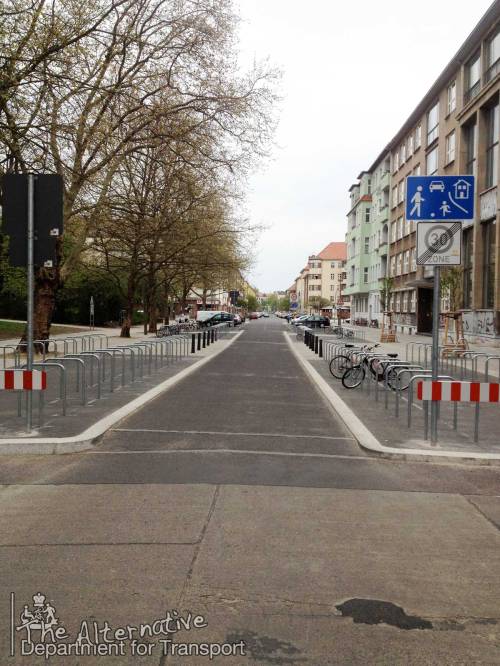Dieser Artikel wurde auch auf Deutsch veröffentlicht.
This article has also been published on my German blog.
There’s a sign which is used on some streets around here, which looks like this:

Share nicely, everybody! (From Wikipedia)
I assumed this means something like “home zone” and it turns out that’s pretty much right.
It marks the start of a “verkehrsberuhigter Bereich” which translates as “traffic-calmed area”. It means:
- Pedestrians may use full width of the street.
- Children are allowed to play anywhere.
- Vehicles must travel at walking pace.
- Drivers must not hinder or endanger pedestrians. They must wait when necessary.
- Pedestrians must not unnecessarily hinder drivers.
There are also some parking and loading restrictions, but the headline is: this should be a place for people who aren’t using a vehicle.
But like the last post about Berlin’s pretend infrastructure, this sign is used on motor vehicle through-routes, and as such is entirely useless.
I’ve seen these all over Berlin. I’ve never seen children playing in them, nor have I seen people walking along them. They’ve all been rat-runs.
Here’s the nearest one to where I live. On one side there’s a park, and on the other there’s a school:
The authorities clearly saw there was a problem here, as the current situation is an improvement over how it was in 2008. There are lots of bike stands, and the road has been narrowed which must discourage some drivers from using it, as they’ll have to wait for any oncoming traffic to clear, but it’s clearly not good enough:
The traffic calming treatment is so weak I can’t understand it. Why isn’t this section of the road closed entirely, and permanently? There’s no need for it to be a through-route at all, as the roads either side of it are also two-way through routes.
Even the local children can see the problem, as they’ve written messages such as “walking speed”, “playing allowed” and “3 – 7 km/h” on the road, in chalk:
I find this really sad.
The children are telling us that there’s a problem here, they recognise that there’s a traffic problem – but the city isn’t listening, so the kids are trying their best to solve it the only way they know how.
Then their chalk pleas are worn away by car tyres.
Luckily, some of the local people are listening, and have set up a weekly “play street” event every Tuesday from the 26th of May. Let’s hope it leads to permanent change.
(Update: Sadly, one local resident didn’t like the one-day-a-week play street. They took the project to court, and the judge agreed. Berlin’s streets are just for the burning of oil, it seems. Read a Google-translated article about it here.)
Perhaps they were inspired by what the children of Amsterdam did in 1972?
“You can keep asking, but if the city doesn’t act you have to do things yourself.”



 The Alternative Department for Transport is written by, and the personal opinion of,
The Alternative Department for Transport is written by, and the personal opinion of, 



I would hardly describe Center Parcs as progressive – the concept seemed a bit tired when I visited. But even there, to guarantee the area is as safe, welcoming and relaxed as possible cars are only allowed in at arrival and departure times. At all other times they’re relegated to the car-park on the edge of the site.
The first playstreets were in Salford over 80 years ago. Child fatalities fell by 90%. I think they disappeared when the iron work was re-cycled into tanks in 1940’s.
In dutch it’s called a ‘woonerf’, and here are some samples on how they’re supposed to look like:



LB Southwark does a lot of this “pretend” infrastructure. It seems unwilling to make changes that anyone might be annoyed by (or even notice) so it proceeds microscopically “nudge” etc using planters to give a “green feel” to its rat runs.
Pingback: Mehr „vorgetäuschte Infrastruktur“ – Gudvanger Straße, Berlin | Das andere Bundesministerium für Verkehr